
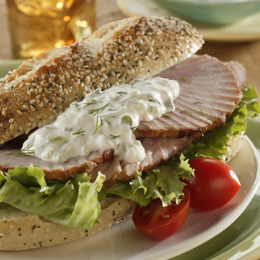
Tzatziki—the classic yogurt-cucumber spread accented with garlic and dill—is a new way accent a pork or ham sandwich. Photo courtesy of the National Pork Board.
February 2005
|
 |
Yogurt Serving Ideas
All Yogurt, All The Time!
Tired of mayonnaise and heavy cream...or looking to cut down on the fat?
Yogurt makes up beautifully in dips, spreads, sauces, marinades, baking. We've included some ideas below. Click here if you’d like to suggest others.
-
Drain off any excess liquid and stir the yogurt before spooning it out of the container.
-
If you want to minimize the tang of yogurt, try the strained Greek yogurts like FAGE Total.
-
For heating yogurt, see instructions below.
Breakfast
Sure, you’ve enjoyed yogurt with fruit and cereal, and possibly in a breakfast smoothie. But how about these cultured alternatives?
Bread Spread: Instead of jam try fruit or honey yogurt on toast, muffins, or scones; mix plain yogurt with preserves for a creamy, less-sweet spread; for a diet spread, mix fat-free yogurt with sugar-free preserves (see Diet Nibbles for our favorites).
Pancakes and Waffles: For a counterpoint to the sweetness of syrups, garnish the plate with some maple or strawberry yogurt.
|
|
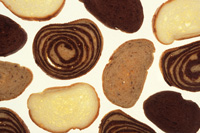 |
| Photo by Scott Bauer courtesy of U.S. Agricultural Research Service. |
Yogurt Parfait: Layer three different flavors of yogurt in a parfait or sundae dish or a goblet. Separate two fruit flavors with a layer of vanilla. You can also use sliced strawberries, blueberries, or very thin banana slices (light enough not to sink) to separate the layers).
Lunch
Sandwich Spreads: Mix equal parts with mustard; mix with minced garlic and fresh snipped dill; mix with curry powder and turmeric; mix with tomato paste and chopped fresh basil (add salt and pepper to taste). For even more dimension, mix yogurt with horseradish plus dill or chives.
Salad Dressing: The same flavors you enjoy as spreads can be thinned for dressing. Thin with lemon juice and flavored vinegars; add a drop of olive oil for texture. You can find dozens of yogurt dressings on recipe websites and in yogurt cookbooks.
Tzatziki: Mix yogurt, chopped cucumbers, minced garlic, fresh dill and chill: literally and metaphorically. Fat-free yogurt is a great diet food; if you’re partial to whole milk yogurt, toast up some pita and enjoy. Click here for a recipe.
Soup: As with the spreads and salad dressings, put the components of tzatziki into the food processor and voilà: cold cucumber soup. Add a bit of milk if you like a thinner consistency. Mix yogurt with tomato or vegetable juice and fresh dill for a low-cal tomato soup, served hot or cold. Or add spices to create curried yogurt soup. Garnish any soup, hot or cold, with a dab of yogurt in the center. Snip chives or dill over the yogurt for extra pizzazz.
|
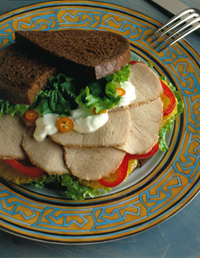 |
California pork sandwich with yogurt spread. Courtesy of National Pork Board.
|
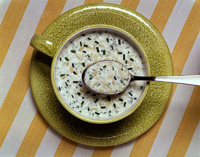 |
| Photo courtesy of National Pasta Board. |
NOTES ON HEATING
Yogurt can be cooked briefly over low heat, but heated yogurt can curdle when not handled carefully. Nonfat yogurt cannot be heated without curdling; but lowfat and whole milk yogurts work fine. Use cow’s, sheep’s, or goat’s milk yogurt: buffalo milk has lower fat, and the fat is needed to prevent curdling.
-
Before heating yogurt for a soup or sauce, bring the yogurt to room temperature. If adding yogurt to a food that is already hot, drain it and stir it well before adding.
-
To cook the yogurt in a hot dish like a paprikash or casserole, stir one tablespoon of cornstarch per cup of room-temperature yogurt prior to adding it. This will enable you to cook it briefly over low heat.
-
Add the yogurt near the end of the dish's cooking time.
Not every yogurt-base sauced needs to be hot. For example, a pasta sauce can be mixed at room temperature and warmed; then tossed onto hot pasta. The heat from the pasta makes it unnecessary to make the sauce equally hot.
Dinner
Sauces: Add yogurt instead of cream to crushed tomatoes and basil for a creamy sauce for pasta or chicken. All of the sandwich and salad concepts from Lunch, above, work as sauce concepts too—for pastas, poultry, fish, beef, lamb, pork, and kabob dipping sauces.
Marinade: Yogurt makes an excellent marinade for meat and poultry. Its acidity is a natural tenderizer.
Appetizers and Snacks
Dips: Substitute yogurt equally for sour cream or mayonnaise in any of your favorite dip recipes.
|
|
 |
| |
Photo courtesy of National Pork Board. |
Garniture: Substitute equally for crème fraîche or sour cream.
Smoothie: Combine yogurt and fresh, ripe fruit in a blender or food processor. If you don't have fresh fruit, combine yogurt with juice.
Desserts
Baking: Yogurt can be substituted for equally for sour cream, buttermilk, or milk in baking, and gives a fine texture to baked products. You need to add ½ teaspoon of baking soda with each cup of yogurt to counteract the acidity.
Dessert Topping: Mix with sugar or sucralose as a topping on pound cake, fruit cake, bundts, and un-iced, drier cakes.

Photo courtesy of TCI Gums |
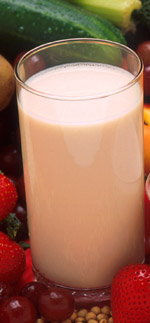 |
| Photo courtesy U.S. Agricultural Research Service |

|










